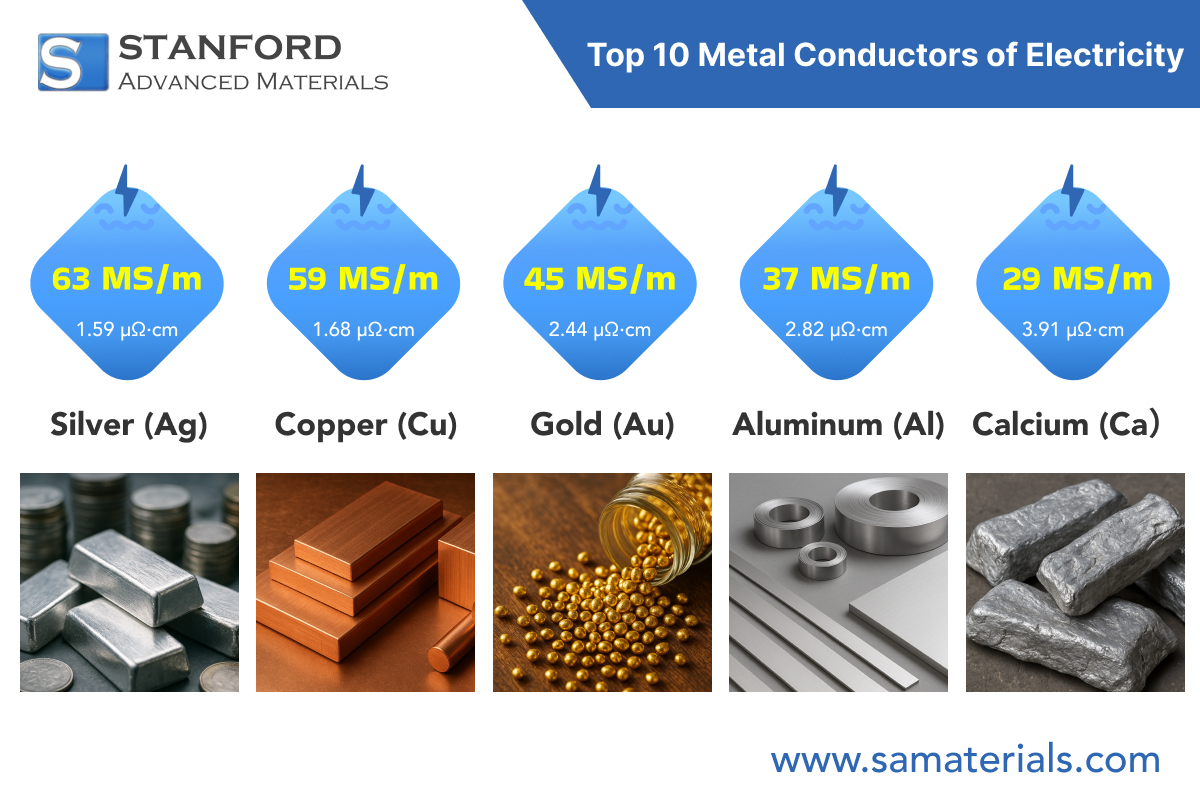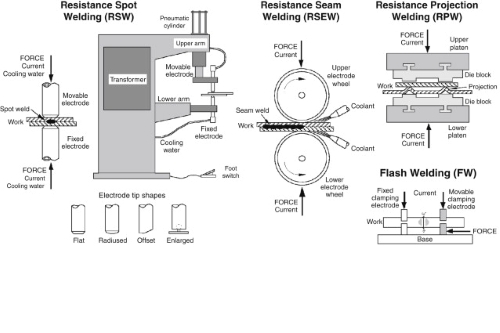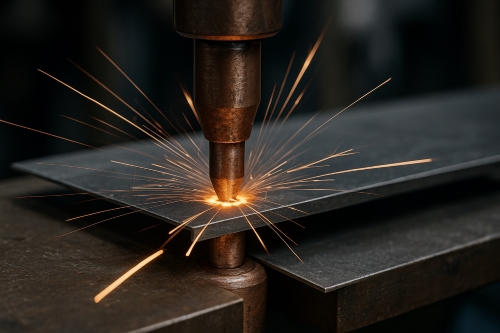Top 10 Metal Conductors of Electricity
Introduction
In daily life, all devices and machinery rely on metals to conduct electricity effectively. Metals serve as the backbone of electrical wires, circuits, and other technologies. We will discuss the list item by item.

Silver (Ag) – 63 MS/m / 1.59 µΩ·cm
Silver is the best of all general conductors. Silver demonstrates high conductivity and is suitable for high-quality and precision connectors. Silver is used where minimal energy loss is critical, although it is expensive. Silver enhances performance in applications such as radio frequency connectors and certain industrial circuits.
Copper (Cu) – 59 MS/m / 1.68 µΩ·cm
Copper is nearly as conductive as silver. Its primary advantages are cost-effectiveness and availability. Copper wire is present in almost every electrical system. The metal is preferred for household wiring, power distribution lines, and printed circuit boards. It provides efficiency with a prolonged lifespan.
Gold (Au) – 45 MS/m / 2.44 µΩ·cm
Gold is not the best conducting metal compared to copper or silver but possesses corrosion resistance. This characteristic leads to its widespread use in electronic components that require reliable performance over extended periods. Gold plating is often seen in contacts, connectors, and high-reliability circuits. The industry relies on it as it remains stable in challenging environments.
Aluminium (Al) – 37 MS/m / 2.82 µΩ·cm
Aluminium is lighter than copper and has satisfactory conductivity per unit weight. Due to its low weight and cost, aluminium is used for high-voltage transmission applications. Overhead transmission lines and busbars frequently employ aluminium, as the reduced weight decreases the load on supporting structures without compromising resistance.
Calcium (Ca) – 29 MS/m / 3.91 µΩ·cm
Though not as renowned as the metals listed above for conducting electricity, calcium possesses average conductivity. More reactive than other metals, calcium is used in specific alloy applications. Researchers and engineers may mix calcium with other metals to enhance conductivity and toughness. Its application in advanced materials illustrates that lesser-known metals play a role in contemporary technology.
Tungsten (W) – 18 MS/m / 5.65 µΩ·cm
Tungsten is renowned for its strength and high melting point resistance. Although not as conductive as silver, copper, or aluminium, it is utilized in high-temperature applications. Tungsten is found in numerous light bulb filaments, with its thermal resistance making it suitable for these contexts.
Zinc (Zn) – 17 MS/m / 5.90 µΩ·cm
Zinc exhibits significant electrical conductance. It is primarily used for galvanisation to prevent rusting. Zinc is occasionally used in batteries and as an alloying element in electrical applications. Zinc enhances the hardness of other metals and provides corrosion resistance in electrical contacts.
Nickel (Ni) – 14 MS/m / 6.90 µΩ·cm
Nickel is another effective conductor. Although it has lower conductivity, nickel offers wear resistance and hardness. Nickel appears in many alloys and is often used to prolong the life of metallic components in machinery and electrical parts subjected to regular use. Its magnetic properties also make it beneficial for certain industrial applications.
Lithium (Li) – 11 MS/m / 9.30 µΩ·cm
Lithium is widely known for use in rechargeable batteries, powering many devices today. Its electrical conductivity is moderate, but its light weight and unique chemical properties render it useful for energy storage. Lithium provides performance alongside weight savings, making it essential for portable devices, electric vehicles, and grid energy storage.
Iron (Fe) – 10 MS/m / 10.0 µΩ·cm
Iron ranks tenth in our list of top metal conductors. It is abundant and possesses strength. While its conductivity is the lowest among these top ten metals, iron's workability and strength ensure it is used in various applications. Steel, an iron alloy, forms the core of modern structures and machinery, making it a vital material in most structural and electrical components.
Conclusion
Metals and alloys constitute the backbone of modern electrical systems. Each conductor on this list possesses distinct characteristics suited for specific applications. Silver demonstrates the highest conductivity but is expensive. Copper and aluminium provide an optimal balance between cost and quality. Gold, tungsten, and lithium serve specialised purposes where their properties are essential. These characteristics would be accounted for by an experienced engineer with the relevant specifications to achieve optimal performance in equipment and infrastructure.
Frequently Asked Questions
F: What determines a metal's ability to conduct electricity?
Q: The electrical conductivity of a metal is determined by its electron mobility and atomic structure.
F: Why is copper used more than silver for wiring?
Q: Copper is abundant, less expensive, and has superior conductivity, thus making it a viable choice.
F: Is aluminium suitable for high-voltage transmission lines?
Q: Yes, aluminium is lightweight and has been employed for high-voltage transmission lines for several decades.

 Bars
Bars
 Beads & Spheres
Beads & Spheres
 Bolts & Nuts
Bolts & Nuts
 Crucibles
Crucibles
 Discs
Discs
 Fibers & Fabrics
Fibers & Fabrics
 Films
Films
 Flake
Flake
 Foams
Foams
 Foil
Foil
 Granules
Granules
 Honeycombs
Honeycombs
 Ink
Ink
 Laminate
Laminate
 Lumps
Lumps
 Meshes
Meshes
 Metallised Film
Metallised Film
 Plate
Plate
 Powders
Powders
 Rod
Rod
 Sheets
Sheets
 Single Crystals
Single Crystals
 Sputtering Target
Sputtering Target
 Tubes
Tubes
 Washer
Washer
 Wires
Wires
 Converters & Calculators
Converters & Calculators
 Write for Us
Write for Us
 Chin Trento
Chin Trento



